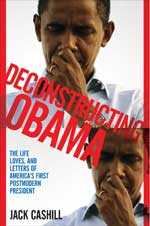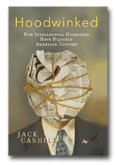Time and Again, Maraniss Conceals Obama’s Socialist Roots
Get your copy of Deconstructing Obama

___
Jack Cashill's book:
Hoodwinked: How Intellectual Hucksters have Hijacked American Culture

Click here for signed first edition
©Jack Cashill
AmericanThinker.com - June 26, 2012
“I’m not writing it as a fact-checker. I’m writing it as an historian,” griped David Maraniss on CNN about the first volume of his new book, Barack Obama: The Story. “Other people for ideological reasons are pouncing on that part of what my book is, but in fact I’m trying to tell the truth.”
In fact, Maraniss is less an historian than a predictably liberal Beltway journalist, one whose own ideology consistently subverts the truth. The distortions are many and significant. In his account of each phase of Obama’s early life—Hawaii, Los Angeles, New York, and Chicago—Maraniss repeatedly conceals the evidence of Obama’s socialist roots to make him appear more of a centrist than he actually was or is.
The sleight-of-hand begins with Maraniss’s discussion of Obama’s Hawaii mentor, Frank Marshall Davis. Predictably, Maraniss introduces Davis as “a black journalist, poet, civil rights activist, political leftist, jazz expert. “ True, Maraniss adds, Davis “had been under surveillance by the Honolulu bureau of the FBI because of his past associations with the Communist Party,” but in progressive circles this qualifier would be read like a tribute.
Given the depth of his research, Maraniss had to know what he was hiding. “Here are the facts and they are indisputable,” writes historian Paul Kengor in his soon-to-be released book, The Communist—Frank Marshall Davis: The Untold Story of Barack Obama’s Mentor, “Frank Marshall Davis was a pro-Soviet, pro-Red China, card-carrying member of Communist Party (CPUSA). His Communist Party card number was 47544.”
The reason the Davis story has remained “untold” until now is because Maraniss and his peers consciously chose not to tell it. As Kengor points out, Maraniss wrote a 10,000-word piece for the Washington Post on Obama’s early years in August 2008 and yet “there was not a single mention of Davis.”
Maraniss can barely bring himself to talk about Davis in this lengthy book. He suggests, in fact, that Obama included “Frank” in his memoir, Dreams from My Father, because he “tended to focus on characters who could accentuate his journey toward blackness.”
Kengor proves otherwise. As he observes, Obama dedicates 2500 words in Dreams to Davis, who “surfaces repeatedly from start to finish, from Hawaii to Los Angeles to Chicago to Germany to Kenya . . . from the 1970s to the 1980s to the 1990s.”
Davis, in fact, played such an essential role in Obama’s formation that, as Maraniss admits, he became “a subject of some of [Obama’s] teenage poetry.” Although I made this case in my 2011 book Deconstructing Obama and Kengor does as well, Maraniss is the first mainstream reporter to concede the obvious.
Obama has had at least two poems about Davis published. “An Old Man” appeared in his prep school’s literary magazine. “Pop” appeared in Occidental College’s. These poems may have been part of a trilogy. A few years prior, Davis had written a poem called “To a Young Man,” which also describes the relationship of a naïve young man with a cynical old man but from the older man’s perspective. A close textual reading leads one to suspect that Davis wrote all three of these poems, including the two fronted by Obama.
When Vanity Fair’s Todd Purdum showed Obama “An Old Man” in 2008, Obama responded, "That's not bad. I wrote that in high school?" He recovered quickly, adding, "It sounds in spirit that it's talking a little bit about my grandfather." “It” wasn’t. Obama was that close to Davis.
In 2008, Obama and his admirers in the media understood that this was a relationship best kept under wraps. Davis never renounced his Communist past. As his FBI file reveals, the Hawaiian Communist Party simply went underground and infiltrated the Democratic Party.
The fact that Davis was a bi-sexual pornographer and nude photographer with at least a fictional taste for underage girls did not make him any more attractive to the readers of the Washington Post. Needless to say, Maraniss was as disinclined to talk of Davis’s unseemly sidelines as he was his hateful diatribes against the likes of George Marshall and Harry Truman.
By Obama’s own account in Dreams, the Marxist Davis was the last person Obama visited before heading to Occidental College in Los Angeles. At Occidental, says Kengor, “Obama was a Marxist himself.” Kengor’s source is John Drew, who founded a Marxist student group on the Occidental campus two years before Obama arrived. Visiting Occidental after graduation, Drew was introduced to Obama by his Marxist girlfriend, Caroline Boss. He met Obama several times, always in radical company, and had an extensive political discussion with him on one memorable night at Boss’s house.
"I'm blown away Maraniss does not pay attention to Obama's ideological extremism," Drew tells me. "I don't see how you make sense of young Obama's time at Occidental without grasping that he was a Marxist planning for a Communist style revolution."
One of about a dozen Occidental students Maraniss interviewed, Boss gets a good deal of play in Maraniss’s book. She apparently was the wealthy white girl whom Obama would transform into the down-home black girl “Regina” in Dreams, one of his many acts of literary alchemy. Drew gets no play at all. "I'm mystified that Maraniss never contacted me," says Drew. By publicly voicing his concerns about Obama on these pages and elsewhere, Drew all but assured that Maraniss would not contact him.
From Occidental, Obama headed to Columbia University in New York. Maraniss ignored Stanly Kurtz’s meticulous research on those years as surely as he did Drew’s observations on the young Obama at Occidental. Again, it is not hard to understand why.
As Kurtz observes in his 2011 book, Radical-in-Chief: Barack Obama and the Untold Story of American Socialism, Obama had a “transformational moment” while attending the Cooper Union Socialist Scholars Conference in 1983. A Harvard Ph.D., Kurtz documents that this was one of the two or three such conferences Obama attended in New York. In Dreams, Obama himself talks about “the socialist conferences I sometimes attended at Cooper Union.”
In Maraniss’ book, there is no mention of Cooper Union. The word “socialist” is used only in reference to people like Boss and Obama’s Pakistani friend Hasan Chandoo, both of whom, Maraniss assures the reader, were “to the left of Obama.”
From New York, Obama moved to Chicago to work as a community organizer in the style of Saul Alinsky. For the record, Alinsky dedicated his book, Rules for Radicals, to “the first radical known to man who rebelled against the establishment and did it so effectively that he at least won his own kingdom — Lucifer.” In Maraniss’s retelling, Alinsky was “an American authentic, radical and pragmatic.” There is no mention of Lucifer.
Like dedicated Marxists everywhere, Frank Marshall Davis among them, Alinsky freely lied about his affiliations to dupe liberal enablers. Still, as Alinsky noted in his first book Reveille for Radicals, he and his fellow travelers hoped “for a future where the means of production will be owned by all of the people instead of just a comparative handful.” No matter what you call it, this is pure Marxism.
Of all of Maraniss’s shadings, none is as conspicuous as his treatment of the radical firebrand, Rev. Jeremiah Wright. Maraniss argues at length that as a mentor and organizer, Alvin Love, a pastor Obama does not mention in Dreams, had more influence on him than Wright, whom Obama mentions often.
To make this case, Maraniss has to ignore the dramatic scene in Dreams in which Obama finds his way to Christianity, or something like it, at Wright’s church. This is the occasion when Wright delivers his famous “Audacity” sermon, the one rich with phrases like “white folks’ greed runs a world in need.”
In the chronology of Dreams, this pivotal scene takes place before Obama goes off to Kenya and then on to Harvard. Although Maraniss’s book covers this period, including the Kenya trip, he makes no mention of the conversion scene, even to debunk it. The scene simply disappears. Indeed, the word “audacity” does not once appear in the book, even though Obama would adapt the name of sermon for his second book, Audacity of Hope.
For those interested in “history,” I would recommend Robert Caro’s recently released fourth volume in his biography of LBJ. For those wanting to be reassured that, regardless of the evidence, the young Obama was just another dope-smoking, basketball playing, all-American pragmatist like you and I, then Maraniss is your guy.
Webmaster's Note: Jack Cashill's Book-TV presentation of "Deconstructing Obama" can be viewed at http://www.c-spanvideo.org/program/298382-1
Editor's note: For a more complete account of this phenomenon, read Jack Cashill's amazing book, "Hoodwinked: How Intellectual Hucksters Have Hijacked American Culture.

